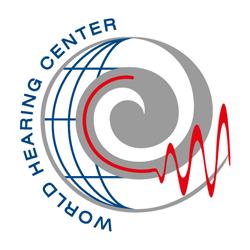Current Issue
Volumes and Issues
For Authors
Manuscript Guidelines
Review Process
Conflict of Interest
Copyright
About the Journal
Editorial Board
Aim and Scope
Policy and Ethical Guidelines
Promotion of the Journal
Print-Version Subscription
Publisher and Contact Information
Contact Information
Sign in
CLINICAL PECULIARITIES OF THE NON-SYNDROMIC
SENSORINEURAL HEARING LOSS IN CHILDREN OF
BELARUS
1
Department of ENT, Belarusian State Medical University, Proezd Slobodskoy 6-202, 220025 Minsk,
Belarus
2
Department of Cytoplasmic inheritance, Institute of Genetic and Cytology National Academy of
Sciences, Belarus
Publication date: 2011-06-30
J Hear Sci 2011;1(2):57-59
KEYWORDS
TOPICS
ABSTRACT
Background:
About 100 genes are determined to be involved in hearing loss in humans. Among them the major one is GJB2 coding connexin 26. The deletion of any one of six G nucleotides at positions 30–35, so called 35delG mutation, is most often found in GJB2 gene in Europeans. The aim of the study was: 1) to analyze 35delG mutation’s rate in the large group of children with moderate-to-profound sensorineural hearing loss (SNHL); 2) to determine the influence of risk factors of non-syndromic SNHL.
Materials and Methods:
392 children (aged 3–17) with SNHL from moderate-to-profound were examined. A screening for 35delG, pure – tone audiometry and family interviews were performed. A comparative analysis of gender characteristics, degree of hearing loss and risk factors in three groups of children: 35delG heterozygous, 35delG homozygous and without this mutation were performed. The influence of risk factors of SNHL was statistically estimated by means of R-System.
Results:
Among children with moderate and profound SNHL 45% were homozygous and 15% were heterozygous for 35delG GJB2. The most significant risk factors leading to deafness in group of patients without mutation were perinatal risk factors.
Conclusions:
Our study revealed that single-nucleotide deletion 35delG in GJB2 is the main genetic cause of SNHL in Belarus as it was detected in homo- or heterozygous state in 60% of the patients with SNHL. A molecular analysis for 35delG mutation should be performed in cases of positive family history, severe – profound congenital hearing loss, presence of perinatal risk factors.
About 100 genes are determined to be involved in hearing loss in humans. Among them the major one is GJB2 coding connexin 26. The deletion of any one of six G nucleotides at positions 30–35, so called 35delG mutation, is most often found in GJB2 gene in Europeans. The aim of the study was: 1) to analyze 35delG mutation’s rate in the large group of children with moderate-to-profound sensorineural hearing loss (SNHL); 2) to determine the influence of risk factors of non-syndromic SNHL.
Materials and Methods:
392 children (aged 3–17) with SNHL from moderate-to-profound were examined. A screening for 35delG, pure – tone audiometry and family interviews were performed. A comparative analysis of gender characteristics, degree of hearing loss and risk factors in three groups of children: 35delG heterozygous, 35delG homozygous and without this mutation were performed. The influence of risk factors of SNHL was statistically estimated by means of R-System.
Results:
Among children with moderate and profound SNHL 45% were homozygous and 15% were heterozygous for 35delG GJB2. The most significant risk factors leading to deafness in group of patients without mutation were perinatal risk factors.
Conclusions:
Our study revealed that single-nucleotide deletion 35delG in GJB2 is the main genetic cause of SNHL in Belarus as it was detected in homo- or heterozygous state in 60% of the patients with SNHL. A molecular analysis for 35delG mutation should be performed in cases of positive family history, severe – profound congenital hearing loss, presence of perinatal risk factors.
REFERENCES (5)
1.
Van Camp G, Willems PJ, Smith RJ: Nonsyndromic hearing impairment: unparalleled heterogeneity. Am J Hum Genet 1997; 60: 758–64.
2.
Petersen MB, Willems PJ: Non-syndromic, autosomal-recessive deafness. Clin Genet, 2006; 69: 371–92.
3.
Schrijver I: Hereditary non-syndromic sensorineural hearing loss. Transforming silence to sound. J Molecular Diagnostics, 2004; 6: 275–84.
4.
Salvinelli F, Casale M, D’Ascanio L et al: Hearing loss associated with 35delG66 mutation in Connexin-26 (GJB2) gene: audiogram analysis. The Journal of Laryngology & Otology, 2004; 118: 8–11.
5.
Janecke AR, Hirst-Stadlmann A, Günter B et al: Progressive hearing loss, and recurrent sudden sensorineural hearing loss associated with GJB2 mutations – phenotypic spectrum and frequencies of GJB2 mutations in Austria. Hum Genet, 2002; 111: 145–53.
We process personal data collected when visiting the website. The function of obtaining information about users and their behavior is carried out by voluntarily entered information in forms and saving cookies in end devices. Data, including cookies, are used to provide services, improve the user experience and to analyze the traffic in accordance with the Privacy policy. Data are also collected and processed by Google Analytics tool (more).
You can change cookies settings in your browser. Restricted use of cookies in the browser configuration may affect some functionalities of the website.
You can change cookies settings in your browser. Restricted use of cookies in the browser configuration may affect some functionalities of the website.



